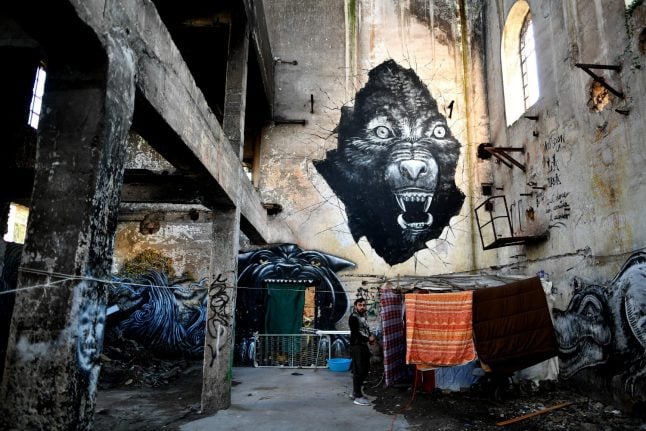ART
Art springs from ruins of Rome’s industrial past
The ruins of a landmark industrial building in Rome have become home to a thought-provoking art project that casts an unflattering light on the capital's patchy record on urban regeneration.
Published: 5 February 2017 13:54 CET

A man stands near a makeshift camp in the ruins of the ex Mira Lanza factory. Photo: Alberto Pizzoli/AFP
Sections of the abandoned shell of the Mira Lanza, once a factory where soap was first produced in Italy, are now home to a collection of works created by Seth, a French street artist who camped, illegally, on the rubbish-strewn site for two months last year.
Now looked after by a group of ethnic Roma migrants, who have set up camp inside the ruins, the paintings and installations created from the on-site debris are already starting to decay.
And that is exactly the point, according to Stefano Antonelli, a director of 999Contemporary, the not-for-profit organisation behind the initiative.
Piled-up books, which initially appeared to provide a seat for a boy painted onto the brick walls of the listed 19th-Century building, have fallen over and now lie encrusted in mud on the soggy floor.
The paintwork on what was the re-creation of an empty swimming pool has been mostly washed away by the rain.
So why not touch up the paint, put the books back in place?
“This is the destiny of these works,” says Antonelli.
“This place has been abandoned since the factory closed in 1957. Since I was a little boy there have been plans to turn it into a museum, student accommodation, something.
“But nothing has ever come of it. So now, we are asking the question: what is the destiny of the Mira Lanza going to be?”
That such a prime site, located a short walk from the trendy downtown neighbourhood of Testaccio and only a few kilometres (miles) from the ancient heart of Rome, should have been left undeveloped for 60 years would be unthinkable in most comparable cities.
That it has been appears to be down to a combination of Rome's chronically weak urban planning – seen most notably in its underdeveloped transport network – and some unfortunate twists of fate.
The books were brought to the site when plans to develop it as an offshoot of a prestigious drama college were at an advanced stage.
But those plans and most of the books went up in smoke when the building was ravaged by a fire that broke out after hundreds of squatters were forcibly evicted from the site in 2014.
In an area the squatters used as a latrine, the artist has painted a crouching boy with his head emerging into the light, a work entitled Lux in Tenebris (Light in Darkness) in homage to how it came to be.
“To clear the space we literally had to shovel out piles of shit – it is not what you usually associate with curating a contemporary art exhibition,” said Antonelli.
Another wall sports paintings of migrants crammed onto boats bound for Italy's southern shores. The colourful images create a similar impression to a run of stained glass windows in a church.
In the adjacent, roofless hall, the surviving, often lopsided, pillars have been painted in the colours of the rainbow to create an installation inspired by the destruction of treasured Roman monuments in Palmyra, Syria, by the Islamic State group.
Since the roof's collapse, the colourful pillars have themselves become damaged history.
A pile of painted bricks provides the support for another painted little boy: “Brickseat” it's called, in a nod to the Brexit vote that had just taken place when Seth was creating the collection.
The Paris-born artist, whose real name is Julien Malland, has created large-scale murals and colourful street art all over the world.
In the aftermath of the 2014 fire, Antonelli's organisation put together a proposal to clean up the site, make it safe and put on a pilot exhibition to demonstrate its potential.
With a budget of 50,000 euros ($54,000), plus the cost of employing an architect for 50 days, that vision won the backing of former mayor Ignazio Marino.
But he was forced to resign on the very day the accord was due to be signed and it was back to square one.
Fifteen months later, the collective is hoping to persuade his replacement Virginia Raggi to sign up.
But with her administration beset by more pressing issues, a resolution of the fate of the Mira Lanza does not look imminent.
Url copied to clipboard!


 Please whitelist us to continue reading.
Please whitelist us to continue reading.